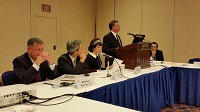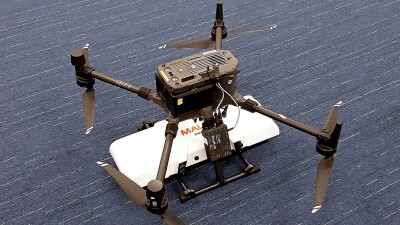Washington, DC, December 12, 2014 – MAPPS Executive Director John Palatiello called on state legislatures to exempt aerial surveying and mapping from any legislation limiting unmanned aerial vehicles (UAV) or unmanned aerial systems (UAS), sometimes derisively called “drones”.
In remarks before the National Conference of State Legislatures (NCSL), Palatiello said photogrammetry and remote sensing provides enormous “societal benefit” and state legislation that limits the use of emerging UAS technology will have “unintended consequences”.
“Photogrammetry and remote sensing, making measurements from aerial photographs taken from manned aircraft, and satellite images, respectively, to make maps, has been in existence for decades without problem or controversy,” Palatiello said. “In many states, photogrammetry is defined as the practice of surveying, requiring supervision by a licensed professional. There are adequate safeguards to protect the public when these activities are performed from UAVs,” he said.
The MAPPS chief executive noted aerial surveying and mapping were specifically mentioned in the FAA “Roadmap” for UAS and earlier this week, FAA approved “exemptions” for commercial operation of UAVs by two MAPPS member firms, Woolpert and Trimble.
He noted that some state legislation has recognized the benefits of mapping from a UAV, and urged NCSL to support such a policy.
“As much as 90 percent of government information has a geospatial information component and up to 80 percent of the information managed by business is connected to a specific location,” Palatiello told the legislators. “Aerial geospatial data acquisition contributes to E911 emergency response and police dispatching systems, precision agriculture, environmental protection, emergency “blue tarp” surveys to support hurricane response, engineering, transportation and infrastructure, and electoral district maps. Geospatial data enables the delivery of critical government services to your constituents and the use of UAVs will make such activities more effective and economical.”
Palatiello said UAVs for geospatial collection will not “dwell over an individual citizen or home, and will not peer into windows.” He noted that existing “Peeping Tom” laws also protect individual citizen privacy. “If you left this hotel and walked down Connecticut Avenue for lunch today, you were surveilled far more than you would ever be by a UAV,” he said at remarks before the NCSL conference at the Marriott Wardman Park Hotel in Washington, DC. He recommended privacy legislation that focuses on the individual citizen in a manner that is “agnostic” to individual technologies, such as UAV.
Palatiello said “Aerial geospatial data acquisition using UAS/UAV provides significant societal benefit and is NOT a threat to individual citizen privacy, and should NOT be limited. Any state efforts to impose limits on UAV/UAS should exempt aerial mapping.”
Palatiello was joined in the state legislative session by State Representative Shelley Hughes (R-AK), State Senator Daniel Biss (D-IL), and FAA Assistant General Counsel Mark Bury. MAPPS is part of a partnership with NCSL that is researching policy issues related to UAVs.
About MAPPS
Formed in 1982, MAPPS is the only national association exclusively comprised of private firms in the remote sensing, spatial data and geographic information systems field in the United States. The MAPPS membership spans the entire spectrum of the geospatial community, including Member Firms engaged in satellite and airborne remote sensing, surveying, photogrammetry, aerial photography, LIDAR, hydrography, bathymetry, charting, aerial and satellite image processing, GPS, and GIS data collection and conversion services. MAPPS also includes Associate Member Firms, which are companies that provide hardware, software, products and services to the geospatial profession in the United States and other firms from around the world. Independent Consultant Members are sole proprietors engaged in consulting in or to the geospatial profession, or provides a consulting service of interest to the geospatial profession.






